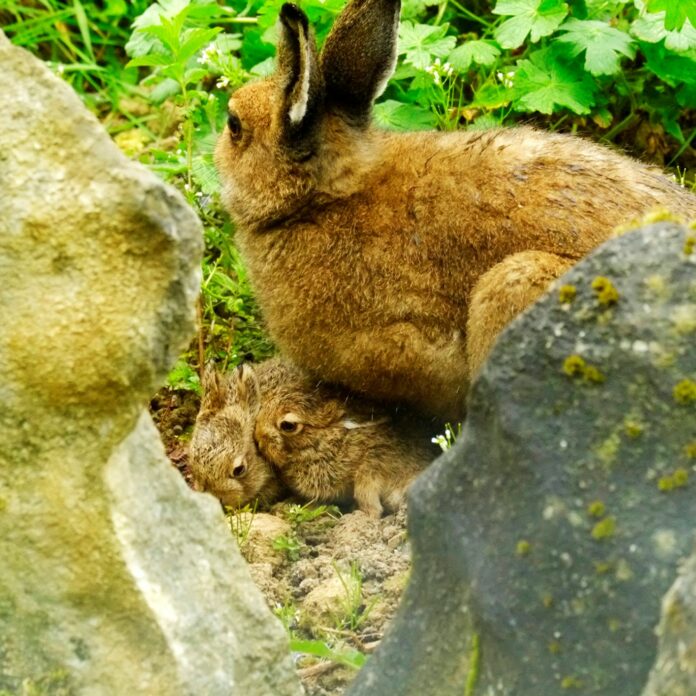KINVARA-based writer and photographer, Irene Graham has released a new children’s book about newborn Irish hares.
“I Am A Hare! Hanna and The Hop Family” is described by Irene as a “heartwarming tale of identity, sense of place and belonging”.
Confused about their identity, thinking they could be rabbits, three adorable newborn hares discover what it means to be a wild Irish hare.
One morning at about 7am a year ago, Irene saw a hare had giving birth to three leverets. Grabbing her camera, Irene photographed the first 50 minutes of their lives.
Irene described this stroke of luck as “incredible” because hares usually give birth in long grass but this particular one delivered her leverets in her rose bed just outside her studio.
After staying with the leverets for about 50 minutes, the mother hare left them and they crawled underneath geraniums, which were also in Irene’s rose bed.
“The leverets are independent when they are born. Their eyes are open, they have fur unlike rabbits who have no fur. The mother hare comes back once a day for about a week to feed them and then they are completely on their own.
“The first night after the birth she moved them to another place in the garden. Two of the leverets stayed around for about three months and we figured one of them didn’t make it because their mortality rate is very high.
“Leverets eat long grasses and herbs. They played around the garden. It was wonderful to see, as the ancient Irish hare that is native to Ireland are among the oldest mammals in the country. The wild Irish hare is still protected in Ireland today,” Irene explained.
She said hares are seen as a symbol of Spring, fertility and rebirth. Using the photographic images of the leverets, she weaved Irish mythology and hare facts into a new story.
Mother hare, Hanna, is not only worried about the safety of her babies from Mr Fox, but knows she has to draw upon folklore to give her leverets ways to survive. They must learn what it means to be a protected species in Ireland.
She knows she has to instill in this generation a way of life from ancient tradition that she wants them to revive.
Hanna names the three leverets one by one and explains what their name means and how it is going to protect them. The leverets keep asking their mother are they rabbits, but she informs them they are not because they longer ears and run much faster than rabbits.
There is a twist at the end where Irene writes about how the Easter Bunny became very popular, but in ancient times it was the hare, which was synonymous with Easter.
“There is great interest in the book. It is one of those books you go ‘aaah’ when you see the pictures. That’s the reaction from adults and children when they see the book. Some people don’t know that baby hares are called leverets,” she said.
The Kildare native moved to live in a few miles from Kinvara village about 16 years ago.
Her first book was about how to write a memoir. Over the last 29 years, Irene has run The Creative Writer’s Workshop teaching people how to write fiction and memoirs.
This has included hosting writing workshops all over Ireland, Clare and Inishmóir.
In 2005, she realised that memoir writing was fast becoming a genre in its own right. Prior to this time, it was mainly autobiographical memoirs mainly written by high profile celebrities.
“I decided I would commit my writing techniques to paper because I use right and left brain writing techniques, which is pretty unusual, teaching people how to write and to tap into their creativity.
“I am very passionate about people writing a little bit of their life story and leaving it in print.
“It took my two years to write the book – The Memoir Writing Workbook. It was launched in the National Library of Ireland by President Michael D Higgins in 2007.
“I then committed this book into a 12-week online writing course. I work with people all over the country and the world, teaching them how to write their memoirs,” she outlined.
Dan Danaher
East Clare correspondent, Dan Danaher is a journalism graduate of Rathmines and UL. He has won numerous awards for special investigations on health, justice, environment, and reports on news, agriculture, disability, mental health and community.



